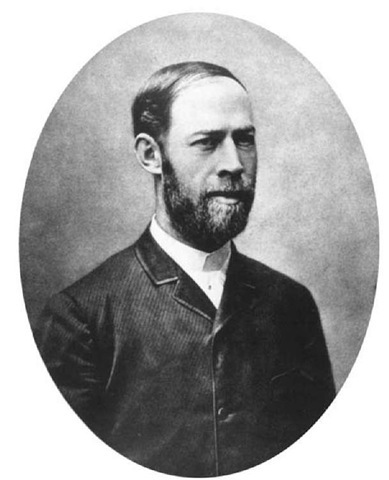Though he died at the young age of 36, Heinrich Rudolf Hertz made significant advances in electrodynamics. Hertz was the first to produce radio waves artificially and succeeded in proving that radio and light waves were electromagnetic waves. A persistent and highly self-motivated researcher, Hertz studied various aspects of electricity, including cathode rays and dielectrics.
The first person to broadcast and receive radio waves, Heinrich Hertz went on to prove that radio and light waves were electromagnetic.
Born into a wealthy family, Hertz was encouraged by his parents, particularly his mother, to excel in his studies. He was born on February 22, 1857, in Hamburg, Germany, the son of Gustav F. Hertz, a barrister, and Anna Elisabeth Pfefferkorn. The eldest of five children, he was educated at a strict private school. At an early age he showed skill at woodworking, as well as a gift for languages. As a teenager he studied Greek and Arabic. In 1875, Hertz went to Frankfurt to gain hands-on experience in engineering but soon decided to pursue an academic and scientific career.
In 1877, Hertz entered the University of Munich to study mathematics and transferred a year later to the University of Berlin, where he studied under physicist Hermann von Helmholtz. Helmholtz proved to be a profound influence on Hertz, and Hertz flourished in Berlin’s rigorous research environment. Hertz received his doctorate in 1880 and spent the next three years as Helmholtz’s assistant. During that period Hertz succeeded in completing the research for 15 publications, the majority of which dealt with electricity. Hertz discussed electromagnetic induction, the inertia of electricity, dielectrics, and cathode rays. It was also during this time that Hertz, with Helmholtz’s prompting, became interested in the electromagnetic theories of james clerk maxwell.
From 1885 to 1889, Hertz worked as a professor of physics at Karlsruhe Technical College. There he began the experimental trials that would drastically impact the field of electrodynamics. By late 1888, Hertz had successfully produced electromagnetic waves using an electric circuit. A metal rod in the circuit possessed a small gap in the middle, and when sparks traversed this gap, high-frequency oscillations resulted. To prove that these waves were transmitted through the air, Hertz set up a similar circuit a short distance from the first and used the circuit to detect the waves. He was also able to demonstrate that these waves were reflected and refracted like light waves, and that, though they traveled at the same speed as light waves, these waves had a longer wavelength. These waves were called Hertzian waves but later came to be known as radio waves. Hertz published his findings in nine papers, which drew significant attention.
Hertz’s discoveries secured him a position at the University of Bonn in 1889, where he continued his theoretical study of Maxwell’s theory. He also returned to the topic of cathode rays and in 1891 turned his attention to a theoretical study of the principles of mechanics as discussed by Helmholtz in his work on the principle of least action.
Among the numerous awards presented to Hertz for his findings on electric waves were the Matteucci Medal of the Italian Scientific Study (1888), the Baumgartner Prize of the Vienna Academy of Sciences (1889), the La Caze Prize of the Paris Academy of Sciences (1889), the Rum-ford Medal of the Royal Society (1890), and the Bressa Prize of the Turin Royal Academy (1891). A unit of frequency, the hertz, was named in his honor. Hertz married Elisabeth Doll in 1886 and had two children. After several years of poor health, Hertz died in 1894 of blood poisoning. Had he lived another decade, Hertz would have been able to see guglielmo marconi’s discovery that the transmission of radio waves could be used as a means of communication.

